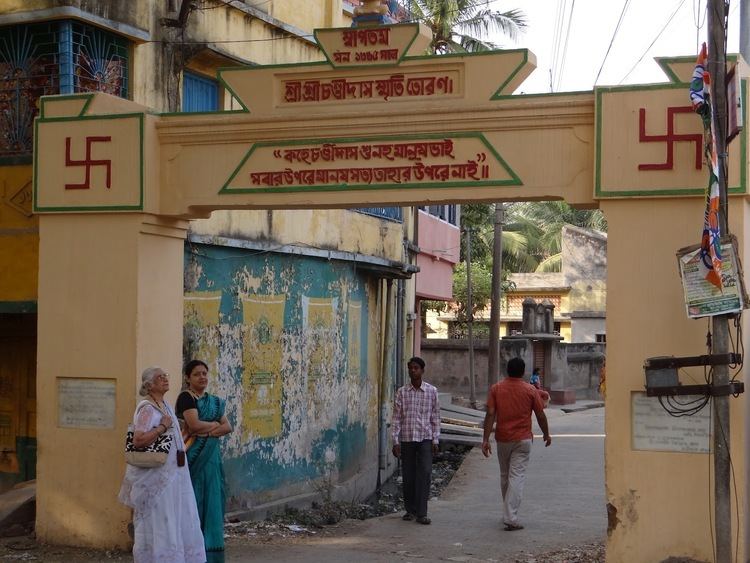PIN 731301 Elevation 24 m | Time zone IST (UTC+5:30) Telephone code 91 3463 | |
 | ||
Nanoor (also spelt Nanur, called Chandidas Nanoor), is a town with a police station in Bolpur subdivision of Birbhum district in the Indian state of West Bengal. Nanoor is the birthplace of 14th century lyric poet Chandidas of Vaishnava Padavali fame. It is developing as a craft centre with NGO support. With the massacres in 2000, Nanoor was in intense media focus.
Contents
- Map of Nanoor West Bengal 731301
- Geography
- Archaeological finds
- Economics
- Nanoor massacre
- Temples
- Fairs
- References
Map of Nanoor, West Bengal 731301
Geography
Nanoor is located at 23.70°N 87.86°E / 23.70; 87.86. It has an average elevation of 24 metres (79 ft).
Nanoor is located in the south-eastern corner of the district which is an alluvial plain between Ajay and Mayurakshi Rivers. It has hot and dry summers, spread over March – May, followed by the monsoon from June to September. 78 per cent of the rainfall occurs during this period.
As per historical records there have been at least 13 intensive droughts between the years 1799 and 1855. The drought of 1836-37 was particularly severe. Floods also wreak havoc. Some 7,000 mud houses either collapsed or remained in bad shape in Nanoor and three other blocks, affecting around 15,000 villagers in 2004.
It is 47 km from Suri, 18 km from Bolpur/Santiniketan and 29 km from Ahmedpur.
Archaeological finds
The archaeological department of Calcutta University organised an excavation programme in Nanoor in 1932 and 1957 but nothing much has happened since then. The archaeological discoveries at Jalundi village in Nanoor block in 2007 are believed to be the ruins of the ancient Pala or Sen dynasties.
Economics
Nanoor Block covering 24 villages, is economically backward. It has many artisan families who live below the poverty line. A large section of the population is either Muslim or belong to the Scheduled Castes and Tribes. Although the population is talented they hardly had an opportunity to earn a decent living. The Institute of International Social Development – an international NGO, based and headquartered in Kolkata, has initiated steps to rectify the situation. The artisans get an opportunity to people from different countries. Such people visit Nanoor to have a first hand experience of the living and working conditions of artisans. Internationally renowned designers are helping the artisans to use the traditional kantha craft for producing modern-day utilities.
Traditionally, there used to be a weekly market, locally called hat. Apart from vegetables, such needs as pottery, wooden materials, iron materials, baskets, seeds etc. were available. With the passage of time the periodicity gradually increased till it became a daily market.
Nanoor massacre
On 27 July 2000, CPI(M) activists allegedly killed 11 landless agricultural labourers in Suchpur, near Nanoor and under Nanoor police station. Just after the massacre CPI(M) leaders said those killed were dacoits but a few days later they admitted that the dead were landless farmers and that they were killed over a land dispute. Two of the CPI(M)'s senior leaders, Anil Biswas and Biman Bose, both politburo members, condemned the Nanoor killings as well as the loss of lives in incidents of violence in the preceding weeks.
The Hindu wrote, “On a long term, the killings, symbolising the birth of a new theatre of violence after Keshpur in district Midnapore - where deaths and maiming in political clashes have become a bizarre routine - constitute an extremely disturbing augury for the society in Bengal."
The prime witness to the Nanoor killings was injured in an attack allegedly by CPI-M activists.The Statesman in an editorial wrote, “The sole purpose in attacking the prime witness in the gruesome Nanoor massacre of July 2000 in which 11 Trinamul Congress supporters were slaughtered by armed CPI(M) cadres was to shield those responsible and abort their trial, by hook or by crook. The irony is that although five years have elapsed since the occurrence of the horrendous killings by the Marxists, the trial of their 79 accused comrades has not yet begun. Repeated postponement of hearing (at least seven in the last two years) because of failure of the accused to turn up in court has made the outcome uncertain.”
The Nanoor area has continued to be turbulent, with political clashes and murders continuing. On the basis of a FIR (first information report) lodged with the police against CPI(M) men, the police made arrests and in August 2001 they submitted charge sheets against 82 accused. The trial started in 2000 and continued for eight years. The court verdict is expected in November 2010.
Temples
There is a temple dedicated to Devi Basuli at Nanoor. The Navaratna temple at Brahmandihi, Kirnahar Vadrokali Tala Temple , Parota Mahaprabhu Tala Temple and the Chand Roy temple and four Shiva temples at Uchkaran are amongst the temples under the protection of the state archaeological department. The renowned Navaratna temple was undertaken by the ASI but is now in bad shape. The four Shiva temples carry somewhat unusual terra cotta sculptures that need preservation. In 2001, the invaluable and rare black-stone Saraswati idol went missing from the Bishalakshmi temple.
Fairs
A fair is organized annually on the occasion of dol purnima (full moon) on the bank of the Dontapukur at Nanoor in memory of Dwija Chandidas and Rajakini (washerwoman) Tami. It is called Chandidas Mela and was earlier organized near Bisalkshi temple.
Japeswar Shiva-Charturdashi Mela is organized at Japeswar in the Nanoor area. Locals here trace back the history of the Shiva temple to 1000 BC.
Radhamadhab Mela is organized at Charkalgram on 14 Chaitra and continues for a week.
Pirer mela is organized at Sherpur for 5/6 days in the month of Magha.
In the month of Falgun, a fair is organized at Basapara. It was started by Atai Mian, a zamindar of the area.
See also - Fairs in Birbhum
